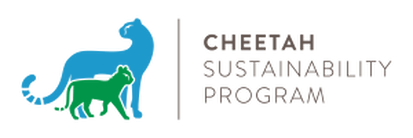|
The Cheetah Sustainability Program (CSP) grows and optimizes the North American cheetah population as an assurance of survival while supporting conservation of cheetahs in the wild. Despite being a unique keystone predator and a charismatic, popular ambassador for African wildlife worldwide, the cheetah has experienced a remarkable decline in numbers from an estimated 25,000 in the early 1980s to no more than 7,000 individuals today. Once cheetahs could be found across the African continent, as well as into Asia and eastern India. Today, due to habitat loss, human-wildlife conflict, and poaching, the cheetah is found in less than 25% of its historic range, mostly now in southern and eastern Africa.
Modeling by the Population Management Center predicted the gradual extinction of the North American cheetah population. The data also demonstrated that more than 90% of all litters were being produced in larger breeding centers ‘off-site’ and away from the public (not in zoos). In response, Conservation Centers for Species Survival (C2S2) launched the Cheetah Sustainability Program (CSP) in 2014 in partnership with the Association of Zoos and Aquarium (AZA)’s Cheetah Species Survival Program (Cheetah SSP). The objective was to create an innovative system to build a long-term, healthy cheetah population in North America while contributing to the conservation of this species in the wild. |
Grow PopulationsCheetah births in the North American assurance population have increased 85% as a result of C2S2's Cheetah Sustainability Program (CSP).
|
Optimize Reproduction & Health
C2S2 develops & leads data-driven, multidisciplinary research to create reproductively and genetically healthy, sustainable populations of cheetahs.
|
Return on Collective AssetsFinancial contributions to the CSP offset a portion of maintenance/ breeding costs and fund peer-reviewed grants to support research and conservation projects.
|
How it Works
The CSP formed partnerships to ensure that prime breeding animals were in the best, most spacious breeding facilities, all while simultaneously being studied scientifically to produce more knowledge. All partners agreed to work together to provide leadership, scientific management, capacity building, and financial support with the singular goal of ensuring species sustainability and serving the greater good of the cheetah. The ten cheetah breeding centers constitute a Breeding Centers Coalition, five of which are C2S2 Members, including Fossil Rim Wildlife Center, Omaha’s Henry Doorly Zoo, Smithsonian Conservation Biology Institute, White Oak Conservation, and the Wilds. Each has sufficient space to accommodate the specific behavioral needs of the species, including increased opportunities for exploring mate choice.
Breeding Centers Coalition
Program Sponsors
C2S2 is taking the lead in the development of a much needed, One Plan Approach population management strategy for the cheetah. Such a global approach involves linking the populations and managing them according to a globally agreed set of goals while building upon and respecting existing regional processes. It is an appropriate strategy for species where the outcomes resulting from a multi-regional alliance demonstrate greater sustainability or conservation deliverables than a single – region approach. This would include identifying and connecting significant in situ and ex situ populations worldwide, across borders and accreditation associations, determining the genomics of the global population, and developing a management plan.







